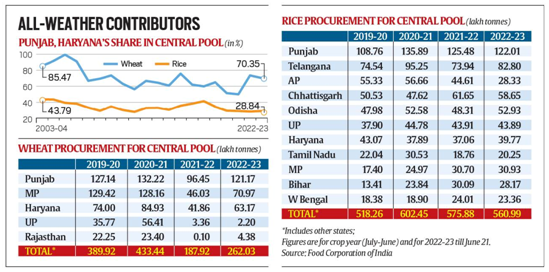Context
- Punjab and Haryana have been India’s breadbasket and crucial contributors to its food security, especially post the Green Revolution.
- But over the last two decades though, the two states’ combined share in total wheat procurement for the Central food-grain pool has fallen from 90% to 70%. For Rice, it has been from 43-44% to 28-29%.
Reason Behind Decline of Two States’ Share in Central Procurement Pool
- The Diversification of Procurement
- Traditionally, the procurement of wheat was concentrated in Punjab and Haryana.
- For rice, the procurement in central pool was mainly from Punjab, Haryana, Andhra Pradesh, and Tamil Nadu.
- Now, with the diversification of procurement, other states have started contributing to central pool.
- State governments are also establishing infrastructure for purchase of grain at minimum support prices (MSP) from farmers.
- For example, MP briefly overtook Punjab as the top contributor to the Central pool in 2019-20 for wheat.
- In rice, Telangana has emerged as a clear number two behind Punjab, with Chhattisgarh, Odisha, and UP making impressive strides over the past decade.

Impact of Climatic factors on Procurement
- Bad monsoon/weather - Low procurement as result of poor harvest: The contribution of most states to wheat procurement has tended to be high largely in “fair-weather” years delivering excellent harvests, such as 2019-20 and 2020-21.
- The immediate impact of a subnormal monsoon would be on the kharif crops, the sowings of which have barely taken off.
- Rice crop may face difficulty because it is a highly water-intensive and requires at least 25 irrigations in the absence of rain.
- Role of El Nino
- El Niño has been associated with monsoon failures in India. Thus, 2014, 2015 and 2018 recorded subnormal rainfall – and all three were El Niño years.
- On the other hand, the country enjoyed four consecutive years of good monsoon from 2019 to 2022.
- Current Situation of El Nino: Its earlier-than-anticipated arrival, and sudden gain in strength between March and May, has cast a shadow over rain in the remaining part of the season. And it will lead to a subnormal rainfall.
- Moreover, if El Niño is going to get stronger, the impact could extend to the rabi (winter-spring) crops.
- These, particularly wheat, are grown using groundwater and dam reservoirs that are recharged/refilled during the monsoon.
- A subnormal monsoon can hit both rice and wheat production which can challenge the food security in the country.
How Can Punjab and Haryana become the saviour states?
- In Punjab and Haryana farmers have assured access to irrigation.
- Even in the event of a poor monsoon, farmers would be able to safeguard their crop because of the presence of 15 lakh electric tube-wells in the state.
- The Punjab government is supplying eight hours of uninterrupted free power daily to run these tube-wells during the four-month paddy season (from transplanting to harvesting).
- Paddy yields in Punjab actually tend to go up during low rainfall years. That’s because farmers then rely solely on groundwater and irrigate their fields accordingly.
Conclusion
- Assured irrigation access has made the two states the most reliable producers of rice and wheat, which will matter in a bad monsoon year.
- For a long time, policymakers and economists have advocated weaning away Punjab and Haryana farmers from rice and also cutting back wheat acreage.
- But today, in a scenario of poor government stocks and soaring rice prices globally, it’s these farmers who may play saviour yet again.









